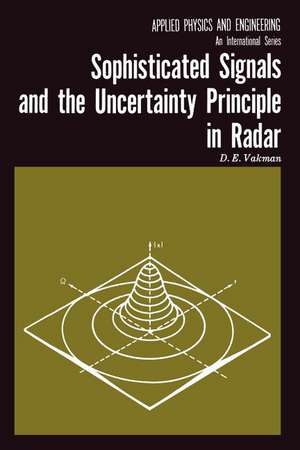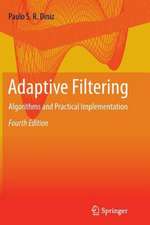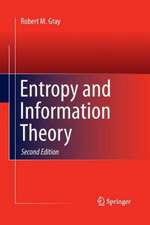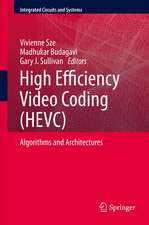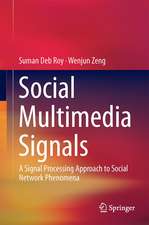Sophisticated Signals and the Uncertainty Principle in Radar: Applied Physics and Engineering, cartea 4
Autor D. E. Vakmann Editat de E. Jacobs Traducere de K. N. Trirogoffen Limba Engleză Paperback – 14 apr 2012
Preț: 638.43 lei
Preț vechi: 751.10 lei
-15% Nou
Puncte Express: 958
Preț estimativ în valută:
122.17€ • 130.64$ • 101.86£
122.17€ • 130.64$ • 101.86£
Carte tipărită la comandă
Livrare economică 18 aprilie-02 mai
Preluare comenzi: 021 569.72.76
Specificații
ISBN-13: 9783642882159
ISBN-10: 3642882153
Pagini: 268
Ilustrații: XII, 254 p.
Dimensiuni: 152 x 229 x 14 mm
Greutate: 0.36 kg
Ediția:Softcover reprint of the original 1st ed. 1968
Editura: Springer Berlin, Heidelberg
Colecția Springer
Seria Applied Physics and Engineering
Locul publicării:Berlin, Heidelberg, Germany
ISBN-10: 3642882153
Pagini: 268
Ilustrații: XII, 254 p.
Dimensiuni: 152 x 229 x 14 mm
Greutate: 0.36 kg
Ediția:Softcover reprint of the original 1st ed. 1968
Editura: Springer Berlin, Heidelberg
Colecția Springer
Seria Applied Physics and Engineering
Locul publicării:Berlin, Heidelberg, Germany
Public țintă
ResearchCuprins
1. Pulse Compression Signals.- [1] Optimal Reception of Signals-Matched Filter.- [2] Response of a Pulsed Signal to a Matched Filter-Correlation Method.- [3] Optimal Reception of Frequency-Modulated Pulse Signals.- [4] Compression Ratio.- [5] Spectrum Compression.- [6] Admissible Errors in the Frequency — (Phase-) Modulation Law for Systems with Pulse Compression.- [7] Formation of Sophisticated Signals.- 2. The Uncertainty Principle.- [8] The Woodward Ambiguity Function.- [9] Examples.- [10] Some Properties of Ambiguity Functions—The Radar Uncertainty Principle.- [11] Analogy with Quantum Physics.- [12] Uncertainty Principle of Quantum Physics.- [13] Other Forms of the Uncertainty Relationship.- [14] Resolution and Selectivity of a Linear Measuring Device.- [15] Resolution of Spectral Analysis.- [16] Measurement of Instantaneous Frequency.- [17] The Generalized Ambieuitv Function.- 3. The Ambiguity Function in the Statistical Theory of Radar.- [18] Sampling Space.- [19] Principle of Maximum Likelihood.- [20] The Ambiguity Function in Relation to Resolution.- [21] The Ambiguity Function in Relation to the Measured Parameters.- [22] Radar Observations and Measurements in Relation to General Physics.- 4. Synthesis of Signals Using Ambiguity Functions.- [23] Some Remarks on Signal Synthesis.- [24] Classes of Signals and Autocorrelation Functions—Statement of the Synthesis Problem.- [25] Synthesis of the Autocorrelation Function from its Magnitude and Phase at Discrete Points.- [26] Synthesis of the Autocorrelation Function from its Magnitude.- [27] Optimal Autocorrelation Functions—Linear Approximation.- [28] Optimal Autocorrelation Functions—Quadratic Approximation.- [29] Synthesis of Autocorrelation Functions Given Over a Bounded Time Interval.- [30] Comparisonof Optimal Power Spectra.- [31] Synthesis of FM Signals from Given Power Spectra.- [32] Phase-Modulated Signals.- [33] Statistical Synthesis of PM Signals.- [34] Synthesis of FM Signals from Two Cross Sections of the Ambiguity Function.- [35] Rotation of the Ambiguity Function.- [36] FM Signals with Uniform Side Lobes in the t,?-Plane.- [37] Approximate Synthesis Method from the Magnitude and Phase of an Arbitrary Ambiguity Function.- [38] Generalization of Synthesis from the Magnitude of an Ambiguity Function.- Appendices.- Appendix 1. Spectra of Wide-Band FM Signals Approximated by the Stationary Phase Method.- Appendix 2. Calculation of Phase Measurement Errors.- Appendix 3. Estimate of Amplitude Distribution for a Signal with Random Initial Phase.- Appendix 4. Determination of the Dolph-Chebyshev Autocorrelation Function and the Corresponding Power Spectra.- Appendix 5. Spheroidal Functions.- References.- Author Index.
